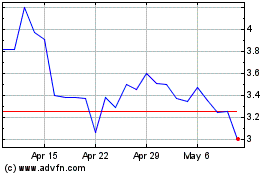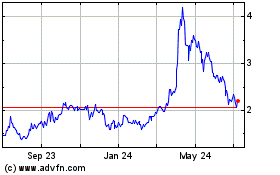Galectin Therapeutics Announces Positive Preclinical Results on the Role of Galectin-3 in Mediating Vascular Remodeling in Pu...
June 02 2016 - 8:00AM

Galectin Therapeutics, Inc. (NASDAQ:GALT), the
leading developer of therapeutics that target galectin proteins to
treat fibrosis and cancer, reports that GR-MD-02, its
development-stage galectin-3 (gal-3) inhibitor, has shown a
positive effect on vascular remodeling in an animal model of
pulmonary arterial hypertension (PAH). The results were presented
at the American Thoracic Society (ATS) 2016 International
Conference by investigators from the Vascular Biology Center and
the Department of Pharmacology and Toxicology at Augusta University
(formerly known as Georgia Regents University) (see poster
presentation).
PAH results in a progressive narrowing of the
pulmonary arteries, which leads to increased vascular resistance
and the elevation of pulmonary blood pressure and, ultimately,
right ventricular heart failure. It is believed that the primary
cause of the permanently elevated pulmonary vascular resistance
that occurs in PAH is due to physical obstruction from vascular
remodeling. There are a number of vasodilator drugs that are
indicated for the treatment of PAH, but additional therapies are
desirable to address the structural narrowing of pulmonary
arteries.
The results of this study demonstrated that rat models of PAH
have significantly increased right ventricular systolic pressure,
right ventricular hypertrophy and pulmonary arterial smooth muscle
proliferation and fibrosis, as well as increased right ventricular
wall thickness and lower pulmonary blood flow. Further, in rats and
humans with PAH, robust induction of gal-3 expression was observed
in the smooth muscle layer. Treatment with the gal-3 inhibitors
GR-MD-02 and GM-CT-01 resulted in marked improvement in the
functional heart characteristics and the vascular remodeling
(smooth muscle proliferation and fibrosis) associated with PAH. A
more complete description of the findings can be found in a
companion CEO Perspective blog post in addition to the poster
presentation.
“The alterations in cardiopulmonary function and
vascular proliferation, as well as in fibrosis were significantly
attenuated by in vivo treatment with specific gal-3 inhibitors,”
said David Fulton, Ph.D., Director of the Vascular Biology Center
at Augusta University. “These findings indicate that gal-3
signaling contributes to the compromised pulmonary vascular
function and prominent pulmonary arterial remodeling that occurs in
PAH, which suggests that inhibition of gal-3 is a strategic and
viable target for treatment of PAH and other related pulmonary
vascular diseases.”
“We are intrigued by the results of this study,
which suggest another important indication for therapy with our
gal-3 inhibitors,” said Peter G. Traber, M.D., chief executive
officer and chief medical officer of Galectin Therapeutics and one
of the study’s authors. “The severity of PAH is such that over half
of patients die of the disease within seven years of initial
diagnosis. A new therapeutic approach that addresses vascular
remodeling would be a welcome addition to the vasoactive drugs
currently on the market.”
About Galectin
TherapeuticsGalectin Therapeutics is developing promising
therapies for the treatment of fibrotic liver disease and cancer
based on the Company's unique understanding of galectin proteins,
which are key mediators of biologic function. Galectin seeks to
leverage extensive scientific and development expertise as well as
established relationships with external sources to achieve
cost-effective and efficient development. The Company is pursuing a
development pathway to clinical enhancement and commercialization
for its lead compounds in liver fibrosis, psoriasis and cancer.
Additional information is available at:
www.galectintherapeutics.com.
Forward Looking StatementsThis
press release contains forward-looking statements within the
meaning of the Private Securities Litigation Reform Act of 1995.
These statements relate to future events or future financial
performance, and use words such as “may,” “estimate,” “could,”
“expect” and others. They are based on management’s current
expectations and are subject to factors and uncertainties that
could cause actual results to differ materially from those
described in the statements. These statements include those
regarding the hope that its lead compounds will be successful in
treating fibrosis and cancer and that those compounds may be
effective in the treatment of pulmonary arterial
hypertension. Regardless of the results of any of its
development programs, Galectin may be unsuccessful in developing
partnerships with other companies or raising additional capital
that would allow it to further develop and/or fund any studies or
trials. For a discussion of additional factors impacting
Galectin’s business, see the Company’s Annual Report on Form 10-K
for the year ended December 31, 2015, and subsequent filings with
the SEC. You should not place undue reliance on forward-looking
statements. Although subsequent events may cause its views to
change, management disclaims any obligation to update
forward-looking statements.
Contacts Jack Callicutt, Chief Financial
Officer (678) 620-3186 ir@galectintherapeutics.com
LHA Kim Golodetz (212) 838-3777 kgolodetz@lhai.com
Galectin Therapeutics and its associated logo is a registered
trademark of Galectin Therapeutics Inc.
Galectin Therapeutics (NASDAQ:GALT)
Historical Stock Chart
From Mar 2024 to Apr 2024

Galectin Therapeutics (NASDAQ:GALT)
Historical Stock Chart
From Apr 2023 to Apr 2024
